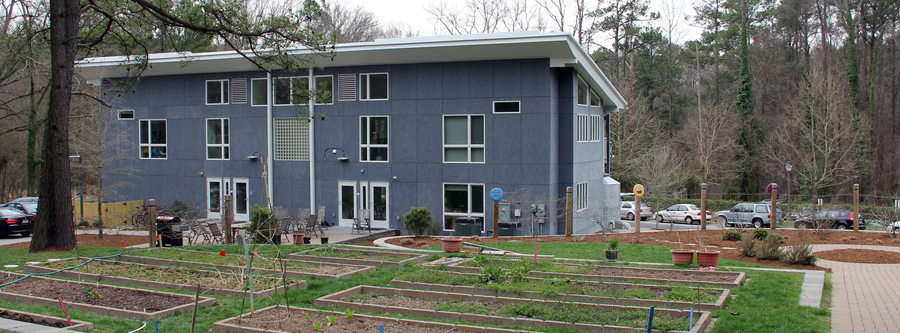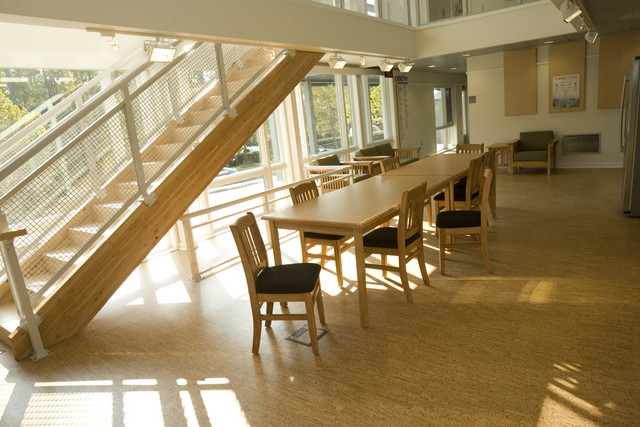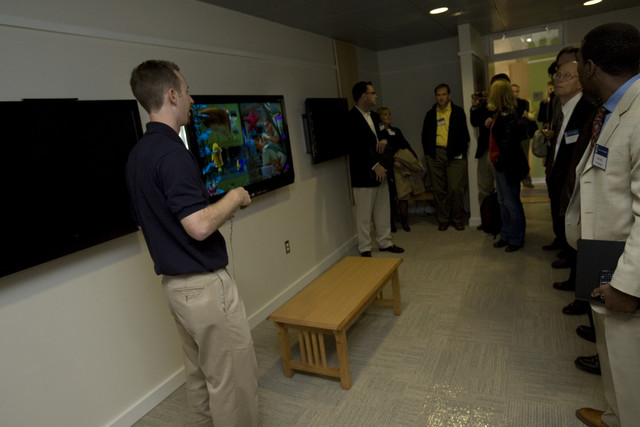
First Floor
Common Area
The common area provides access to any room on the first floor—and most are open with the bedroom as the only exception.

Architect Frank Harmon opened the ceiling to the roof to provide openness and to passively circulate air. This chimney effect provides passive thermal cooling.
The laundry area is outfitted with ENERGY STAR-certified appliances.
The common room is furnished with a dining room table to seat 10 residents, and chairs and sofas.
Clean Lab
On the southeast corner of the building. The labs were designed without doors to create a sense of openness—the lab space blends seamlessly with the living space, allowing innovation to connect with all parts of the home, rather than being confined to a single room.
In the clean lab, you can find computers, an e-Print station, and monitors that show the status of house systems.
Media Room

An all immersion based multimedia experience. Studentsdesigned it to be a creative, user-friendly combination of television, gaming, and movie experience. There are no exterior windows. This was chosen so that room lighting may be configured to any type of room display. Acoustic walls enhance sound effects.
Dirty Lab
A place to build and test products. It is equipped with almost everything that will help a student with an idea to work through a problem.
Guest Restroom
The guest bathroom has the same layout of the upstairs bathroom, but it is about a foot larger in both dimensions.
Showers incorporate hot water generated from the solar system on the roof. The toilets incorporate water collected from rainwater harvesting.
Second Floor

The second floor is the private space of the home.
- There are five double bedrooms in the home
- Each bedroom is approximately 250 square feet and comes furnished with two each of: 3/4 loft, desk and chair, bookshelf, dresser, and wardrobe
- A two-person lab counter is provided in each room, with a window view
- Adjoining bedrooms share a bathroom except for the first floor, which has a guest bathroom.
- The ceiling on the second floor begins at the standard height of 8 feet and rises up to 18 feet in the back
- Smart Panels test projects and incorporate things within the entire home
Basement
The basement houses mechanical systems such as heat pumps, duct work and plumbing, and control panels.

It also houses six 350-gallon rainwater harvesting tanks, and filtration, and solar hot water collection tanks.
- Heat Pumps: HVAC systems consume a significant portion of the energy used in buildings. Electric heat pumps, supplied by Trane are used to both heat the home in the winter, and cool the home in the summer. Central heat pumps are more efficient than conventional heating/air conditioning units. Not only do they combine multiple units into one, but they also simply move existing heat from outside to inside or vice versa instead of actually generating heat (i.e. through electrical resistance, or burning fossil fuels). Our ultra efficiency units have a SEER (Seasonal Energy Efficiency Ratio) of up to 16 (Cooling Efficiency) and a HSPF (Heating Seasonal Performance Factor) of up to 9.85 (Heating Efficiency). For a comparison, the current national efficiency standard for new heat pumps requires a minimum SEER of 13 and a minimum HSPF of 7.7. The ENERGY STAR qualification is given at a SEER of 14, and a HSPF of 8.
- Refrigerant: The refrigerant used in the HVAC system is R-410a, which is an environmentally friendly alternative to normal refrigerants used in air-conditioning systems. It replaces R-22 (freon) which has some potential for depleting the o-zone layer, and will be phased out in the United States by 2020. Our refrigerant does not contribute to o-zone depletion.
- Energy Recovery Ventilator The Smart Home contains an energy recovery ventilation unit to pre-heat (or pre-cool) incoming air from outside the home with warm (or cool) exhaust air.
- Trane Clean Effects: The air in the Smart Home is purified by the Trane CleanEffects air purification system that filters air and creates up to 99.98% cleaner air via electrically charged fields making it easy to clean (simply wipe the filters). The system is 8 times more effective than the best HEPA filters and 100 times more effective than the standard 1 filter or ionic-type room appliance. The system removes 12% of 0.3 micron sized particles from the air in Smart Home every minute.
